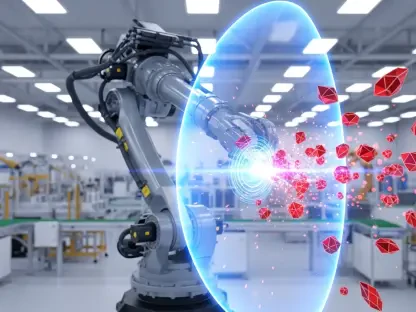In an era where artificial intelligence is reshaping every facet of technology, Intel has emerged as a powerhouse with its ambitious expansion in Chandler, Arizona, and revolutionary strides in semiconductor innovation. This strategic push not only bolsters domestic manufacturing capabilities but also cements Intel’s role as a frontrunner in AI-driven computing solutions. With the unveiling of cutting-edge facilities and next-generation processors, the company is addressing the surging demand for high-performance, energy-efficient technology. By investing heavily in American infrastructure and pioneering advanced process nodes, Intel is tackling global supply chain vulnerabilities while setting new benchmarks for the industry. This multifaceted approach, combining state-of-the-art production with AI-optimized platforms, highlights a transformative vision for the future of computing, positioning Intel to meet both current market needs and long-term technological challenges with unparalleled expertise.
Building the Future in Arizona
Intel’s expansion at the Ocotillo campus in Chandler, Arizona, marks a significant milestone in strengthening U.S.-based semiconductor manufacturing. The introduction of Fab 52, supported by a staggering $100 billion investment in domestic operations, underscores a commitment to high-volume production of advanced logic chips. This facility is poised to become a cornerstone of American technological leadership, drawing on over five decades of research and development expertise rooted in the United States. By establishing a robust hub in Arizona, Intel is not only enhancing its capacity to produce cutting-edge technology but also contributing to a more resilient supply chain. The focus on domestic infrastructure reflects a broader goal of reducing reliance on foreign manufacturing, aligning with national priorities to secure technological sovereignty in an increasingly competitive global landscape.
Beyond the physical expansion, the Chandler facility represents a strategic pivot toward integrating advanced manufacturing with innovation. Fab 52 is designed to support both internal product lines and external customers through Intel Foundry services, positioning the company as a trusted partner in the AI era. This dual-purpose approach ensures that the benefits of technological advancements are widely accessible, fostering collaboration across industries. Additionally, the Arizona hub complements research efforts in Oregon and packaging operations in New Mexico, creating a comprehensive ecosystem for semiconductor development. This interconnected network enhances Intel’s ability to rapidly scale production while maintaining high standards of quality and efficiency, setting a precedent for how domestic manufacturing can drive progress in a critical sector.
Pioneering Technology with Intel 18A
The Intel 18A process node stands as a groundbreaking achievement in semiconductor design, offering a 2-nanometer class technology that redefines industry standards. With up to 15% better performance per watt and a 30% improvement in chip density compared to its predecessor, this innovation delivers unmatched efficiency and power. Key features like RibbonFET, a novel transistor architecture, enable superior scaling, while PowerVia, a backside power delivery system, optimizes energy flow and signal integrity. Now ramping up for high-volume production in Chandler, Intel 18A is set to underpin multiple generations of products, ensuring long-term relevance. This leap forward not only enhances the performance of computing devices but also positions Intel as a leader in addressing the escalating demands of AI and data-intensive applications.
Further distinguishing Intel 18A is its incorporation of Foveros technology, which facilitates advanced 3D chip stacking for flexible system-on-chip designs. This capability allows for tailored solutions that can adapt to diverse market needs, from consumer electronics to enterprise systems. Initially developed in Oregon, the transition to production in Arizona signifies a seamless blend of research and manufacturing prowess, ensuring that innovations reach the market swiftly. The implications of this technology extend beyond immediate performance gains, promising a foundation for sustainable computing through energy-efficient designs. As industries grapple with balancing power consumption and computational needs, Intel’s advancements offer a compelling pathway to meet these challenges head-on, reinforcing the company’s influence in shaping the technological landscape.
Transforming Consumer Tech with Panther Lake
Panther Lake, part of the Intel Core Ultra Series 3, emerges as a game-changer for AI PCs, gaming devices, and edge solutions, built on the cutting-edge Intel 18A node. With shipping slated to begin later this year and wider availability expected by January 2026, this processor promises over 50% faster CPU performance and graphics capabilities compared to the prior generation. Boasting up to 180 Platform TOPS (trillions of operations per second), Panther Lake delivers exceptional AI acceleration, catering to the growing need for intelligent, responsive systems. Its scalable multi-chiplet architecture ensures versatility across various form factors and price points, making it a cornerstone for next-generation consumer technology. This processor is set to redefine user experiences in personal computing and beyond, aligning with the rapid evolution of AI-driven applications.
Extending its impact, Panther Lake also supports innovative edge applications, such as robotics, through a specialized Intel Robotics AI software suite and reference board. This enables cost-effective development in AI perception and control, opening new possibilities for industries reliant on automation and real-time processing. Whether powering high-end gaming rigs or enabling smart devices at the edge, the processor’s design prioritizes both performance and power efficiency, mirroring broader trends toward sustainability in tech. By addressing diverse use cases, from casual users to specialized developers, Intel demonstrates a nuanced understanding of market dynamics, ensuring that Panther Lake meets immediate demands while paving the way for future advancements in intelligent systems.
Redefining Data Centers with Clearwater Forest
Clearwater Forest, the upcoming Xeon 6+ processor, is tailored for hyperscale data centers, cloud providers, and telecommunications, with a launch previewed for the first half of 2026. Built on the Intel 18A process node, it features up to 288 efficient cores and a 17% increase in instructions per cycle over its predecessor, delivering significant gains in density and throughput. This processor is engineered to help organizations scale workloads efficiently, reduce energy costs, and provide smarter services amid the escalating demands of modern computing. By focusing on power efficiency, Clearwater Forest addresses a critical pain point for data center operators facing rising operational expenses and sustainability goals, positioning Intel as a vital partner in the enterprise space.
The strategic design of Clearwater Forest reflects an acute awareness of the evolving needs within data-intensive environments, where performance and cost-effectiveness must coexist. Its ability to handle complex workloads with reduced power consumption offers a competitive edge for businesses navigating the challenges of digital transformation. Beyond raw performance, the processor supports the delivery of intelligent services, enabling cloud providers to meet the growing expectations for speed and reliability. As data centers become the backbone of AI and cloud computing, Intel’s focus on tailored solutions underscores a commitment to driving efficiency at scale. This development signals a forward-thinking approach to infrastructure, ensuring that enterprise clients can future-proof their operations in a rapidly changing technological landscape.
Shaping a New Era of Computing
Under the guidance of CEO Lip-Bu Tan, Intel’s recent advancements are framed as catalysts for a transformative era in computing, blending next-generation platforms with unparalleled manufacturing capabilities. The emphasis on U.S.-based operations, particularly through the Chandler expansion, reinforces a historic role in American technology leadership while addressing global supply chain uncertainties. This vision prioritizes innovation across consumer and enterprise markets, ensuring that AI-optimized solutions meet a spectrum of needs. By aligning technological breakthroughs with strategic investments, Intel is not just responding to current trends but actively shaping the trajectory of the industry, fostering resilience and competitiveness on a global scale.
Looking back, Intel’s efforts through initiatives like Fab 52 and the Intel 18A node demonstrate a profound commitment to advancing semiconductor technology while fortifying domestic production. The rollout of Panther Lake and the preview of Clearwater Forest showcase how targeted innovations can redefine both personal and enterprise computing. Moving forward, stakeholders can anticipate further integration of AI capabilities into everyday technology, supported by scalable architectures. Exploring partnerships through Intel Foundry services and investing in sustainable practices will be critical next steps. As the landscape evolves, staying attuned to emerging demands and leveraging these advancements will ensure continued progress in building smarter, more efficient systems for the future.









